Max and George’s Excellent Adventure: the Pros and Cons of Night Sights

Max and I enjoying some fine MRE cuisine at Davis Field, Oklahoma. Which was a different adventure than the one in this story.
Night Sights Work Both Ways
This story begins in a Village Inn pancake house off Miracle Mile in Tucson, Arizona.
“You know what you need?” I said. “Some night blasting.”
Max is one of my oldest and dearest friends. His mother had died when he was young. When this adventure took place, his father had recently joined her. I had flown back to our home town to be there for him.
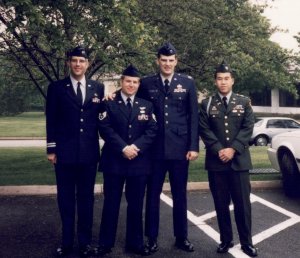
Max and I were drinking coffee. It was well after midnight. He was really bummed. I thought some night-time shooting would cheer him up. We both loved to shoot guns (and still do), and there are fewer things more fun than seeing muzzle flash silhouetting your sights in the dark.
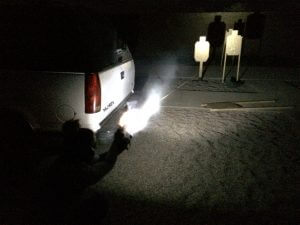
Having flown in, I was traveling light. Not to worry; Max’s firearms collection made mine look like Nancy Pelosi’s. A couch at his hotel included loaner guns, rather than a mint on the pillow. For that particular blasting expedition, he fronted me a double stack Para-Ordnance .45 with glowing tritium night sights.
We also chose to shoot his suppressed Heckler & Koch MP5. We tossed that, some targets, and ammo into the Honda I was borrowing from my mom while I was in town, and headed to the hinterlands.
The place we liked to shoot was way out in the desert, in the middle of the Altar valley west of Tucson. There were some 40′ tall dirt berms out there, left over from a planned open pit mine or sewage treatment plant or some such. The berms made a safe place to stop our bullets. Nobody lived near there (three decades ago), so we wouldn’t have to worry about disturbing anybody’s sleep at 0200.
Or so we thought.
As we drove out into the desert, I said “I wonder how that old man is doing.”
We both chuckled.
On our way to a previous night blasting session in the same place, we had come across a drunk older gentleman staggering down the road, six or more miles from the nearest civilization. Turned out he’d been at a bar off Kinney Road on the edge of town. He thought he was walking home, but he had taken the street on the left instead of the one on the right. He only lived a few blocks from the bar and couldn’t figure out, in his alcohol-induced stupor, why it was taking him so long to get home.
It gets cold out in the desert at night. I think it was in the 40s. Not freezing, but possibly cold enough to induce hypothermia if he passed out on the desert floor out there. That’s how USMC Corporal Ira Hayes, who’d helped raise the American flag on Iwo Jima’s Mt Surabachi, had died on the Akimel O’odham (Gila River) Nation near Bapchule, Arizona, about 80 miles north of where we were.
We gave the old man a ride back to his house, then Charlie Miked (continued the mission).
No drunks on the road, on the night this story took place. No traffic of any kind, at that hour, that far out in the middle of nowhere.
The closest dirt road we could park on was a hundred meters or so from the berms. We got out, collected up our gear, and hiked.

When we got to the berms, we set up a pair of IPSC cardboard targets and commenced what we called “Ding Chavez drills,” named after a character from the Tom Clancy novels, an Army Sgt who was particularly adept at sneaking up on enemy sentries.
We would start back 30 or 40 meters from the targets, walk quietly up to about 15 meters, and then fire a pair of shots with the MP5. We’d brought ear muffs, but didn’t wear any hearing protection for those drills, because the H&K was suppressed, and we were listening to see how quiet we could be while moving.
Suppressors, erroneously called “silencers,” aren’t as soundless in real life as they are in the movies, but the sound of the rounds passing through the targets and hitting the berm, plus the noise of the dirt, sand and pebbles kicked up off of the berm, and the sound of the MP5 bolt cycling, was louder than the shots themselves. The empty brass hitting the dirt did not make the tinkling noise it would have, if it had fallen on concrete.
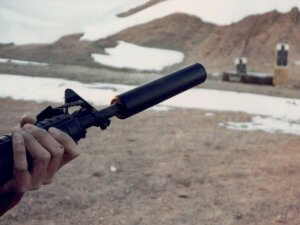
We each made a few runs, trying to emulate our fictional hero Domingo The Stealthy. Max, being a light infantry Ranger, was pretty good at it. I, the lazy AF type who always rode from my post to the chow hall and back, made considerably more crunching noises on the gravel of the desert floor.
We were standing by the targets, discussing the pros and cons of different aiming methods in the dark, and different “turtle tracking” quiet movement techniques, when somebody coughed.
It wasn’t me.
“Did you just cough?”
“No. Didn’t you?”
“No . . . “
We strained our ears, but heard nothing.
“You did hear somebody cough, right? I wasn’t hallucinating?” I whispered.
“I heard it too. Maybe we should unass this AO.” That was Army speak for leaving a particular area of operations. Max was always the smarter one of us.
“We’re pretty heavily armed,” I said. “I’m not too worried about whatever boy scouts are out here camping. Let’s just poke around a bit, and see what’s going on.”
Against Max’s better judgement, we moved westward down the south side of the berm, trying to be even quieter than we had when sneaking up on the cardboard sentries. When we got about 2/3 of the way to the end of the big berm we’d been shooting into, we heard very light shuffling sounds coming from the top of the berm at our 4 o’clock, above and slightly behind us.
We both turned and looked up in that direction.
Using “look beside it” night scanning techniques we’d learned in the military, we could see somebody on the top of the berm.
He raised something long and skinny and pointed it into the sky.
He cranked off two rounds from his rifle.
The flashes were bright. It sounded like a .22 to me, but I might’ve been experiencing auditory exclusion. It might’ve been a .30-30 for all I know. On the other hand, my body might’ve been enhancing my hearing due to the lack of visual stimuli.
It seemed clear he was firing it into the air. Maybe as a signal to someone else. Certainly as a signal to us that he was also armed.
“That’s it,” Max said. “We’re outta here.”
I wholeheartedly concurred.
Max took point. I drew my own pistol and followed, trying to keep an eye on the guy, who was now back toward our 7 o’clock.
We slowed near bushes and sped up between them, but in the middle of the bajada, where we were, the vegetation is relatively sparse.
That was when I noticed how very BRIGHT those night sights were. Looking at Max I could also see the rear sights of his holstered pistol glowing. The guy on the berm would have no trouble tracking–and shooting–us by following the luminous dots we were carrying around.
A decade and a half later, when Max was at Tal’Afar castle (an ancient Ottoman fortress) in Iraq, an insurgent sniper shot a sentry, who was smoking, through a small slot in the rampart, which Max remembers as no more than half a meter wide. The light of the cigarette was visible at night to the sniper, estimated to be 250 – 300 meters away, across a wadi on the east side of the citadel. A little light can be seen from some distance at night.
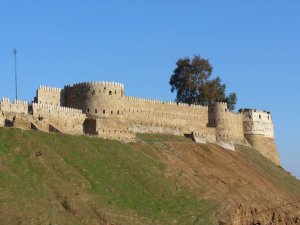
Meanwhile, back in the Altar Valley . . .
Holding the pistol in my dominant right hand, I put my left palm over the rear sight and jammed the tip of my middle finger up against the back of the front sight. That seemed to block most of the light from my pistol–but not from Max’s, since both of his hands were on the MP5.
We got to the car. I felt a sense of relief as I holstered up and jumped in, reaching across to unlock Max’s side (yes, they were manual locks and windows).
Then we saw the lights of the truck.
It looked like a jacked up 4×4. It was coming right at us.
Max said something about the Altar Valley being a notorious drug smuggling route, and maybe we’d stepped in into something smelly. As we raced away, Max hung out the window, ready with the MP5.
The truck chased us.
The main road, when we got back to it, was thankfully very straight, because I looked down and noticed I was doing 90 mp–with the lights off. The pedal was floored. 90 was about all we were gonna get out of a 4-cylinder Accord. “You’d better strap yourself in,” I suggested. “If I wreck this rice burner, you’re gonna be toast.”
Max did, but still kept an eye on them.
After a while the truck, having chased us off, turned around, killing his lights. I eventually turned on my lights, but we kept going at a high rate of speed, till we were east of the Tucson Mountains.
When I hit the road, I was really wheelin’
Had the gravel flyin’ and the rubber squealin’
And I didn’t slow down till I was almost to Arkansas
–Charlie Daniels, Uneasy Rider
Knowing what I know now, having spent years of my life since then as a Border Patrol agent hunting smugglers in the dark, it’s likely that there was a crew of “mules” with dope inbound to that location.
Probably not there yet. The truck might’ve been waiting to pick up the load and ferry it farther north.
Smugglers also place scouts–and radio repeaters–on hill and mountain tops, like forward artillery observers, to steer the mules clear of Border Patrol agents. They steal trucks in Phoenix, camouflage them, and use them as resupply vehicles, with car batteries for the repeaters, radio batteries and food for the scouts. It’s like a military operation.
And they are armed, with night vision and guns often, ironically, provided to the Mexican military to help them stop the corrupting drug trade. Mexican cartels murdered 23,000 people in 2016 alone, surpassing the deaths in Iraq and Afghanistan.* Smugglers torture people and hang their headless bodies from overpasses to make a point. They have shot my friends and coworkers, and continue to do so despite our nationwide rush to legalize substances that ruin lives.
Your country is being invaded all night, every night, by slavers and smugglers importing poison for your children. Most of the policy makers in DC, and most of the people they represent, have absolutely no clue that this is happening.
The dopers and flesh peddlers prefer it that way.
The load they were probably waiting for was likely being brought to them on foot (they also use horses). The berms were visible from a considerable distance away, even by moonlight, and made a good landmark to steer towards.
Their armed escort probably thought we might be a rip crew, and wouldn’t have been sure till they scouted the area and found our targets (if they stuck around) that we were just a pair of hapless off duty military firearms enthusiasts, in the wrong place at the wrong time.
Others have not been so fortunate. Ranchers working their land along the southwest border have been killed and dumped down old mine shafts. I’m guessing part of the reason the guys in the truck didn’t shoot at us was because they could see Max leaning out with a SMG, quite ready to shoot back.
The lesson of night sights–like tracers–working both ways stuck with me. On the range, the “bad guy” is in front of you, and your glowing sights usually point the other way.
In the real world, bad guys can be all around. Perhaps even above and behind you, from where your night sights are clearly visible.
I’ve used that “palm over the slide to block the light of the night sights” method several times in my career since then.

Night Sights not Required
In the Air Force, my issued Beretta M9 had white “dot the i” markings on the black sights. They did NOT glow in the dark. The military is more concerned about giving away your position than they are about collateral damage from missed shots. But the high-contrast white markings can make it easier to pick up the sights in late afternoon / early evening or even pre-dawn light.
When night sights started being readily available on the civilian market, my “go-to” off-duty gun was an M1911A1, made in 1943, with teeny tiny iron sights. They were designed to be durable in combat. They were difficult to pick up at all (much less at night), but once you found them, they were fairly precise at distance. The ordnance folks correctly figured that if an enemy jumped into your trench, up close, you were as likely as not to be target focused, aiming over rather than through the sights. Either way, they lacked the real estate or modularity to be easily replaced or modified with luminous tritium vials.

One Dot System: Cyclops
The first gun I owned that would readily accept night sight installation was the gen 2 Glock 19 I carried as a police officer and a state law enforcement park ranger in the mid 1990s. Neither department required night sights (the federal agencies I worked for later did; in fact, they mandated three dot systems). Still, I could see that night sights conferred certain advantages over irons when it came to hitting in the dark (this was decades before reflex optics were common on pistols).
I never woke up in a cold sweat with PTSD from our (somewhat humorous in retrospect) adventure in the Altar Valley, but I was still concerned about giving away my position with glowing rear sights hanging out of my duty holster. I bought a set of Trijicon B&Ts (the product name B&T stood for “bright and tough”), but only installed the front sight.
Glocks come standard with a one dot system: Glock’s white “box the dot” markings serving the same purpose as (and probably slightly more effective than) the “dot the i” markings on the Beretta M9. Like they M9s, they are high contrast, visible with some light, but not self-luminous, so not visible in no (or very low) light.
After I replaced the front sight only, the luminous dot of my Trijicon front sight was easily visible through the (non luminous but high-contrast) white box around the rear sight notch, in almost all lighting conditions.
The metal Trijicon sights had a slightly different height than the plastic rear sights that came standard with Glocks. This might have made for elevation errors but the difference was not great enough to matter up close, and I shot enough in those days to be reflexive about the requisite holdover or -under (can’t remember which, now) at distance.
In fact, in most lighting and most fighting conditions, all you need to pick up in a hurry (if you need a sight at all) is the front sight. My rear sight didn’t give away my position as I waited in an alley or snuck up a set of back stairs. Many agencies have gone to embroidered badges for the same reason.
I’m surprised the idea of only having a luminous front isn’t more popular. Surely I’m not the only person to have thought of it.
Perhaps predictably, I nicknamed that Glock 19 “Cyclops.” It now has night sights on both front and rear (don’t shoot enough any more to stay sharp about elevation issues), but the Cyclops name has stuck.
Two Dot Systems
My favorite night iron sights for pistols, so far, are the Heinie Straight 8 Ledge. The “ledge” is a sharply upswept angle to the front surface of the rear sight that lets you hook the rear easily on pants, the top of a holster, or whatever to cycle the slide one handed if necessary. Some other sights have similar setups (see Hookable Front Surfaces below).
The “Straight 8” is two luminous dots. You stack the front dot on top of the rear dot, not entirely unlike “dotting the i” of the M9’s high contrast (non luminous) black and white sights.
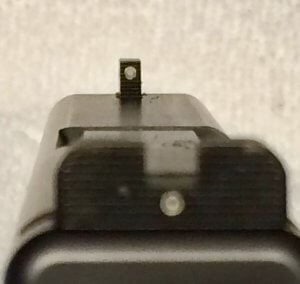
Stacked dot systems can help eliminate windage errors, if you do your part. They are simpler, and in a fight, simple is good.
One possible drawback of stacked pairs of dots (as opposed to 3 dot systems; see below) is potential elevation errors. How high does one hold the front dot over the rear dot?
The late, great Louis Awerbuck pointed out to Max, our friend Jay, and me that people without night sights have a tendency to shoot high at night. Louis theorized that it might be caused by people tilting the front of the pistol up to silhouette and find that front sight, then losing sight of it when they try to place the front in the rear notch, so then coming up again, erring on the side of too high rather than too low.
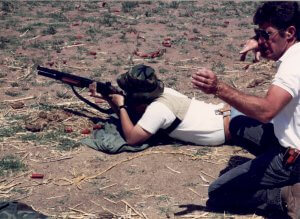
Elevation is an obvious concern in hostage rescue. Even if you’re not on the FBI HRT, you could find yourself doing hostage rescue solo, if you hear glass breaking in your daughter’s room. Snatching the wrist down is a far more common cause of low shots, but regardless of what causes them, low hits could be disastrous if you are aiming at a bad guy’s head over a loved one’s or partner’s shoulder.
To test if stacked dot systems are actually problematic, I ran some Heinie Straight 8s on a gen 4 Glock 19 against some hostage taker targets, in the indoor shoot house at Pima Regional Law Enforcement Training Center. Even though I had not worked with those Heinies much before that, I had zero difficulty hitting exactly as high as I wanted while moving through the rooms.
That was a limited test, but I’ve duplicated the results in other low-light training situations since. I put the dots pretty close together, and have zero elevation issues.
Three Dot Systems
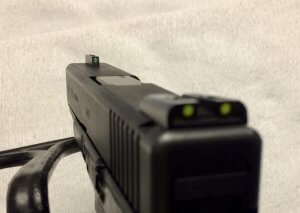
Three dots are by far the most popular night sights. I first saw 3 dot (non-luminous, high contrast) sighting systems on H&Ks in the 1980s. Three dots have only have two drawbacks that I’m aware of.
- The two dots in the rear are twice as bright and much closer to your eyes than the one in the front, which makes the rear dots tend to draw your focus, and
- There is a phenomenon where you can get the front sight level with the other dots, but to the left or right, thinking one of the rear dots (the one that winds up in the middle) is the front sight instead.
Number two could potentially lead to some windage errors. In reality, the “which one is the front” problem is not much of an issue if you have any depth perception whatsoever. If you keep both eyes open, it should not be an issue. If you’re still not sure, and you have time, wiggle the front of the slide left and right a little. The dot that moves most is your front.
At least one company, TruGlo makes 3 dot night sights with a different colored front dot, which (if you have color vision in that range) eliminates the question of which dot is the front sight altogether. Their TFO sight is available with a green front and yellow rear luminescent dots.
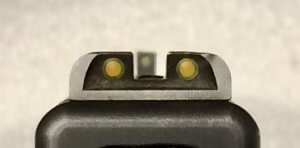
Night Fighting 101
If you are facing a (potentially) armed opponent in the dark, there are 3 things you need to do:
- Find potential threats. Once you find one, you need to
- Identify whether or not he IS a threat. Then, if he is, you must
- Hit your threat.
Luminous sights only help with 3. They can even make 1 and 2 more difficult. Here’s an example.
It was a dark and rainy night . . .
. . . in the lower Rio Grande Valley, the silty, occasionally swampy region not too far from where the river flows into the Gulf of Mexico.
It had been raining steadily for a week.
The dirt roads were all impassable.
Hiking across the fields was even worse. With each step, I sank in past my knees. The mud vacuum-sucked my back leg with each step.
We’d received multiple hits on a sensor near the Rio. That particular landing was popular with dope loads, and multiple hits over an extended period of time usually indicated some sort of transshipment activity.
It was virtually impossible to move out there. If I’d thought it was just aliens I would’ve waited to see what happened. But intercepting a load of poison bound for America’s schools was another matter.
It took me an hour and a half to cross a field only a half-mile wide. The sensor was in a wide loop of the meandering river that bent back and almost touched itself to form an oxbow. I waited at a spot near the narrow isthmus with river channels on each side.
It was really, REALLY dark. In most places, cloud cover reflects back and increases ambient light. In that rural portion of southmost Tejas, lights were few and far between; there was little or no light for the clouds to reflect. Instead, the thick cloud cover merely blocked out the starlight. Even the thick humid air seemed to diffuse and absorb light as well as sound.
Most likely they would be following a road (muddy, too, but easier than slogging across a field as I had done) that ran along an embankment and then turned toward me.
Barely, using the “look beside it” methods mentioned above, I saw three shadowy figures come around the bend in the road.
Anticipating dopers with an armed guard (or 2 or 3), I raised my .40 caliber Beretta 96D–and they disappeared. It was so dark, my night sights completely blinded me to being able to see even their dark silhouettes.
Immediately, I whipped out a flashlight and lit them up with photons. They dove for brush along the bank, but soon surrendered. No mas extranjeros. I looked to see if they’d dropped any packs or bundles, but found no narcotics.
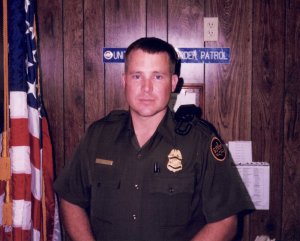
Later, when they were drying out and warming up in the back of my heated rig, I found they’d tarried so long at the landing because it was so slick, they had great difficulty even climbing up the river bank.
Night Sights: Good or Bad?
Does this mean I think you should not have night sights?
No, it does not. I highly recommend self-luminous night sights for most social work.
Unless you are a Navy SEAL who infils and exfils your way to and from your worksite in the dark, night sights probably have far more advantages than disadvantages for you.
If you can afford night sights and ammo and a flashlight, get them.
If you can’t afford all three, get ammo and a flashlight.
If you can’t afford both, get a flashlight.
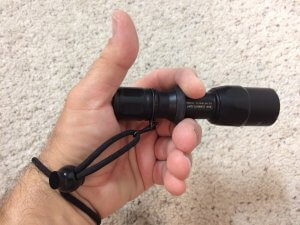
Again, a flashlight can help you find and identify threats. Night sights only help you hit them. If you don’t have night sights, a flashlight can help you silhouette your sights by illuminating your target.
With a Neck Indexed, handheld flashlight, you can use the aura, or periphery, of your light to illuminate your sights if necessary.
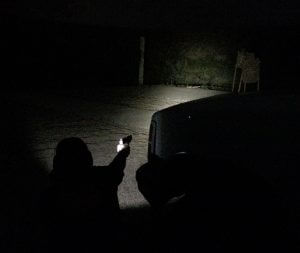
Night sights work best in mixed lighting conditions. Think of the movie theater in Aurora, Colorado when that bozo who wanted to be the Joker came in and shot the place up. Depending on where you were sitting, he could have been far enough away to require carefully sighted fire; it was neither completely dark nor brightly lit. In those conditions, bright night sights would be worth your pistol’s weight in platinum.
Luminescent Markings
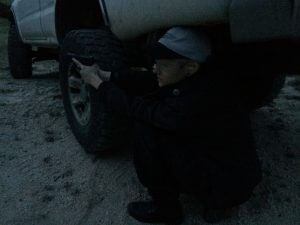
This Heloderm student’s pistol has luminescent, not to be confused with self-luminous, sights. They are barely visible in the photo, and were barely visible during that class. Barely visible is actually better for your night vision–till after the first shot, when your night vision literally disappears.
Like those glow-in-the-dark Halloween stickers, luminescent paint on sights absorbs ambient light, storing it up and giving it back later. The glow can last for minutes or hours (as opposed to years for luminous sights). The light from luminescent markings on your sights may not be there when you need it, especially if you store the gun in a safe (as you well should). Even if they have some glow, luminescent sights may not be bright enough in partially lit environments like a movie theater with a bright image on the screen.
The majority of fights happen in reduced light. Not that many happen in complete darkness.
Think about parking garages, and other urban settings.
In daylight, the luminescent paint can perform the same high contrast function as the non-luminescent white “dot the i” and “box the dot” markings on Berettas and Glocks. Luminescent markings are not a bad idea; just don’t depend on them.
Hookable Front Surfaces
Regardless of whether or not you choose to run night sights on your pistol, one thing I highly recommend on your REAR sights is a VERTICAL, or NEAR VERTICAL, front surface. That allows you to hook the rear sight on your gear or pants in order to cycle the slide one handed, if necessary.
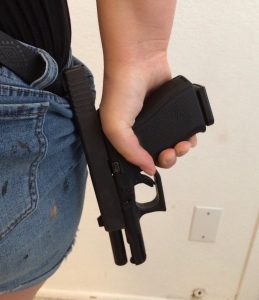
Some rear sights come with ramped, streamlined fronts. With Novak sights, it was their main selling point.
The pistol backs out of the holster and out from under cover garments, so streamlining the front of the sight serves little purpose unless you are an Olympic sprinter trying to reduce wind drag. If you are constantly chasing people through very thick brush, you are either a Border Patrol agent, or you need to rethink your strategy. However, there was originally a practical reason (now mostly forgotten) for ramping the front surface of the rear sight.

In the days when single-stack .45s dominated IPSC (International Practical Shooting Confederation) competition, it was important to conserve ammo. One cleared a stovepipe type stoppage by “wiping” the empty case out of your ejection port with your bladed hand in a quick rearward motion. This kept you from dumping the next (live) cartridge, which was halfway up the feed ramp, onto the ground.
A streamlined front surface to the rear sight saved wear and tear on your hand during that stovepipe-wiping process.
These days, we generally default to TAP – ROLL RIGHT – RACK instead. This clears most stoppages (including stovepipes) with the advantage of being non-diagnostic: it’s not something we have to think about while our mental bandwidth is dominated by assessing the tactical situation. The disadvantage of TAP – ROLL RIGHT – RACK is that it is likely to dump a live cartridge on the ground. Not so much of a problem with high-capacity pistols, but that can be an issue with the new breed of micro-compacts.
If you are down to one hand in a fight, you could conceivably fix a stovepipe by wiping it out of the ejection port on your belt or the lip of your holster or whatever. But it is almost impossible to cycle the slide (for failures to feed, failures to chamber, bad primers, etc) one handed with a ramped front surface to the rear sight.
For that reason, several sight manufacturers now tout rear sights with a vertical or even hooked forward surface.
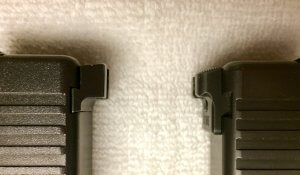
The Trijicon HD (“Hard Duty”) sights on the left, and the Heinie Ledge sights on the right, both feature a vertical front surface for hooking on things to cycle the slide one handed.
Both also extend back from the dovetail to offer slightly more sight radius, which can help with accuracy.
The rear surface of the HD is angled like an overhanging cliff to cast some shadow on the rear sight. This makes its silhouette crisp, but has the disadvantage of causing some wear and tear to cover garments. I learned that the hard way carrying concealed as a special agent. In the Trijicon line I prefer their B&Ts (Bright and Toughs), which have a lower profile and are easier on shirts, for concealed carry.
One thing I love about the HDs is that in daylight, they are essentially a single dot system. The tritium filled vials of both front and rear are the same size, and equally luminous in the dark, but the one in front has a brightly colored, luminescent ring around it. This makes it really jump out at you in daylight; it’s one of the few front sights I can actually pick up while sprinting full speed off the X in a forward oblique.

TruGlo’s Tritium Pro and TFX Pro sights have a similar concept. There are different color options. The circular outline around the front vial of Trijicon’s HD comes in a greenish yellow (like some fire engines) or reddish orange. I found that the yellow outline front stood out better for me against most backgrounds.
Incidentally, yes, you are correct. The rear sight on the Glock above is in the right side of the dovetail. After they are zeroed for me, Glock rear sights are inevitably right of center. As a field armorer and instructor for my agency, I found that most right handed Glock operators hit better with the rear sight slightly to the right.
The gun itself, if locked in a vice, would almost certainly hit where the sights are pointing if the rear sight is centered in the dovetail. But I think the way most of us (especially those of us with smaller hands) come at the Glock trigger is from 1 o’clock (or 11 for lefties), rather than 12. I compensate for this poor trigger manipulation by adjusting the rear sight to compensate. It works for me.
Reflex Sights
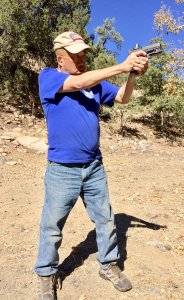
If you run an RMR or other reflex “red dot” optic on your pistol, I HIGHLY encourage you to supplement it with night sights.
But, you think, isn’t the red dot itself an effective night sight?
Yes, yes it is.
IF you can find it in the dark.
Having luminous sights on your reflex sight equipped pistol may sound confusing, but in fact they make it easier to locate, and then “hand off” to, your reticle in the dark.
Incidentally, the large, vertical front surface of a durable reflex sight like the RMR provides the ultimate handle for one handed slide manipulation. In 2020 I injured the fingers of my left hand, but I was able to cycle the slide of an RMR equipped Glock with just my palm. I could also easily hook it on a holster or the corner of a wall one handed.
Conclusion
Over decades of running firing ranges, and shooting both professionally and competitively in reduced light, I can tell you that most people shoot more accurately in the dark. Darkness forces them to look at their night sights, rather than their target.
Worst case, even without night sights, it forces them to illuminate their target, silhouetting their sights.
Shooting tight groups is not the be-all and end-all of fighting; far from it, in fact. But there is a time and place for aimed, accurate return fire. Should you need to hit at distance, in mediocre ambient light, night sights can be life savers.
–George H, lead instructor, Heloderm LLC
*Stats on Mexican cartel homicides are from the annual Armed Conflict Survey by the International Institute for Strategic Studies, cited in Jared Keller’s “Mexico Surpasses Afghanistan and Iraq As The World’s Second Deadliest Conflict Zone,” TaskandPurpose.com, 09 May 2017. The deadliest conflict at that time? The civil war in Syria.
